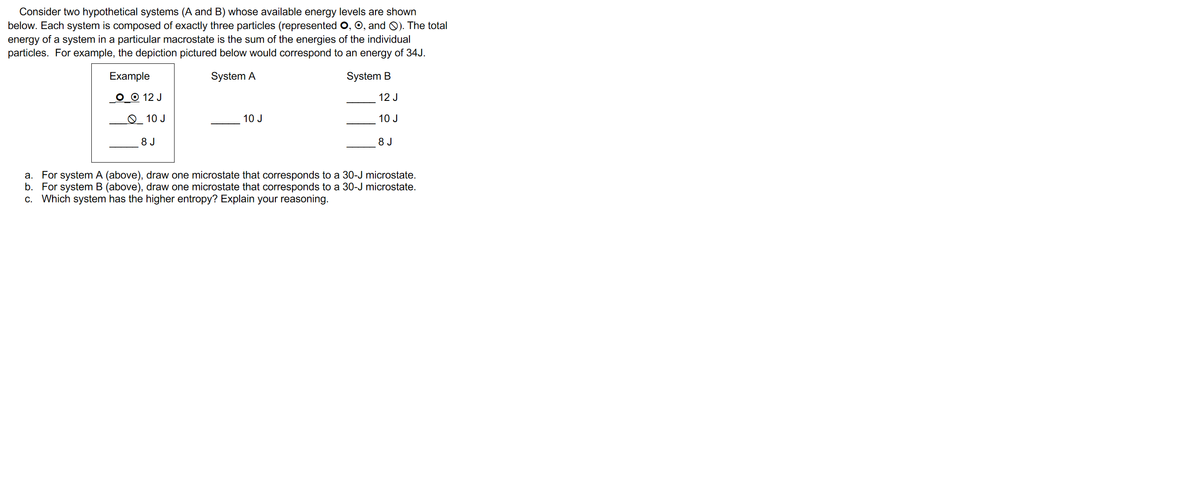Consider two hypothetical systems (A and B) whose available energy levels are shown below. Each system is composed of exactly three particles (represented O, O, and O). The total energy of a system in a particular macrostate is the sum of the energies of the individual particles. For example, the depiction pictured below would correspond to an energy of 34J. Example System A System B O_0 12 J 12 J LO_ 10 J 10 J 10 J 8 J 8 J a. For system A (above), draw one microstate that corresponds to a 30-J microstate. b. For system B (above), draw one microstate that corresponds to a 30-J microstate. c. Which system has the higher entropy? Explain your reasoning.
Consider two hypothetical systems (A and B) whose available energy levels are shown below. Each system is composed of exactly three particles (represented O, O, and O). The total energy of a system in a particular macrostate is the sum of the energies of the individual particles. For example, the depiction pictured below would correspond to an energy of 34J. Example System A System B O_0 12 J 12 J LO_ 10 J 10 J 10 J 8 J 8 J a. For system A (above), draw one microstate that corresponds to a 30-J microstate. b. For system B (above), draw one microstate that corresponds to a 30-J microstate. c. Which system has the higher entropy? Explain your reasoning.
Chemistry & Chemical Reactivity
10th Edition
ISBN:9781337399074
Author:John C. Kotz, Paul M. Treichel, John Townsend, David Treichel
Publisher:John C. Kotz, Paul M. Treichel, John Townsend, David Treichel
Chapter20: Environmental Chemistry-earth's Environment, Energy, And Sustainability
Section: Chapter Questions
Problem 23PS: Energy consumption in the United States amounts to the equivalent of the energy obtained by burning...
Related questions
Question

Transcribed Image Text:Consider two hypothetical systems (A and B) whose available energy levels are shown
below. Each system is composed of exactly three particles (represented O, O, and O). The total
energy of a system in a particular macrostate is the sum of the energies of the individual
particles. For example, the depiction pictured below would correspond to an energy of 34J.
Example
System A
System B
O O 12 J
12 J
10 J
10 J
10 J
8 J
8 J
a. For system A (above), draw one microstate that corresponds to a 30-J microstate.
b. For system B (above), draw one microstate that corresponds to a 30-J microstate.
c. Which system has the higher entropy? Explain your reasoning.
Expert Solution
This question has been solved!
Explore an expertly crafted, step-by-step solution for a thorough understanding of key concepts.
This is a popular solution!
Trending now
This is a popular solution!
Step by step
Solved in 3 steps with 3 images

Knowledge Booster
Learn more about
Need a deep-dive on the concept behind this application? Look no further. Learn more about this topic, chemistry and related others by exploring similar questions and additional content below.Recommended textbooks for you

Chemistry & Chemical Reactivity
Chemistry
ISBN:
9781337399074
Author:
John C. Kotz, Paul M. Treichel, John Townsend, David Treichel
Publisher:
Cengage Learning

Chemistry & Chemical Reactivity
Chemistry
ISBN:
9781133949640
Author:
John C. Kotz, Paul M. Treichel, John Townsend, David Treichel
Publisher:
Cengage Learning

General Chemistry - Standalone book (MindTap Cour…
Chemistry
ISBN:
9781305580343
Author:
Steven D. Gammon, Ebbing, Darrell Ebbing, Steven D., Darrell; Gammon, Darrell Ebbing; Steven D. Gammon, Darrell D.; Gammon, Ebbing; Steven D. Gammon; Darrell
Publisher:
Cengage Learning

Chemistry & Chemical Reactivity
Chemistry
ISBN:
9781337399074
Author:
John C. Kotz, Paul M. Treichel, John Townsend, David Treichel
Publisher:
Cengage Learning

Chemistry & Chemical Reactivity
Chemistry
ISBN:
9781133949640
Author:
John C. Kotz, Paul M. Treichel, John Townsend, David Treichel
Publisher:
Cengage Learning

General Chemistry - Standalone book (MindTap Cour…
Chemistry
ISBN:
9781305580343
Author:
Steven D. Gammon, Ebbing, Darrell Ebbing, Steven D., Darrell; Gammon, Darrell Ebbing; Steven D. Gammon, Darrell D.; Gammon, Ebbing; Steven D. Gammon; Darrell
Publisher:
Cengage Learning

Chemistry
Chemistry
ISBN:
9781305957404
Author:
Steven S. Zumdahl, Susan A. Zumdahl, Donald J. DeCoste
Publisher:
Cengage Learning

Chemistry: An Atoms First Approach
Chemistry
ISBN:
9781305079243
Author:
Steven S. Zumdahl, Susan A. Zumdahl
Publisher:
Cengage Learning
